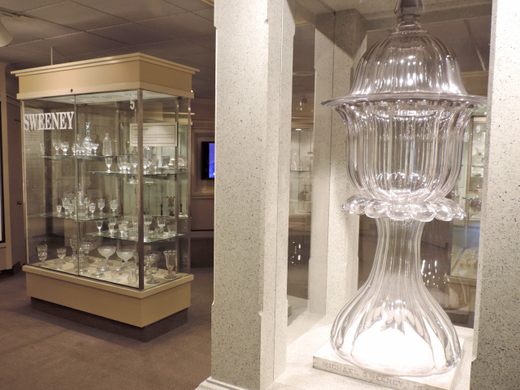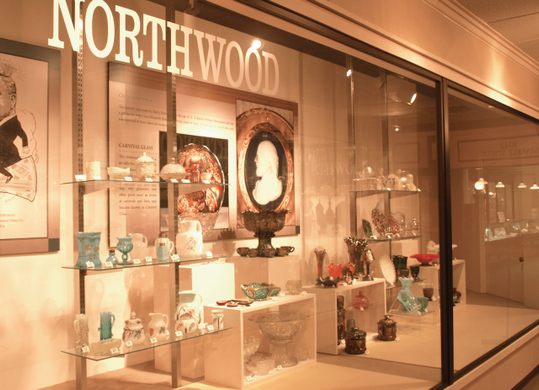Sweeney Punch Bowl
The largest piece of cut lead crystal adorned a grave for 75 years and is now the shining star of a glass museum.
At five feet tall and weighing 225 pounds, the Sweeney punch bowl looks all party and sparkle. Its legacy is shaped by widespread renown and its final resting place at the Oglebay Institute Glass Museum continues a trajectory of lasting fame. But this marvel of glassmaking also comes with a dark graveyard tale of spite, sundered brotherly love, and vandalism.
The story begins when four Sweeney brothers from Pittsburgh formed the North Wheeling Glass Company in Wheeling, West Virginia, in 1835. Two of the brothers died in the early years of the company, leaving the remaining two, Thomas and Michael Sweeney, to bear the mantle. In 1844, Thomas designed the Sweeney punch bowl. Nothing like this gigantic receptacle for sugared spirits had ever been attempted before. The bowl could hold 16 gallons of punch, and was made using five separate wooden molds, which were likely later destroyed in a factory fire. The large, ornate cut glass pieces—comprising a base resembling an upturned champagne coupe, a petalled collar, an undulating central bowl, a lid, and a decorative finial—were meant to showcase the technical expertise of the glassmakers, and were effective stunts to elevate the North Wheeling Glass Company brand. A second Sweeney punch bowl of similar scale was also made. Meant to tour the world, it is sadly thought to have succumbed on a steamboat journey from New York back to Wheeling, when the boat sank. Before the second version disappeared, both bowls had won prizes at industrial fairs in New York and Philadelphia. A third one, much smaller in size, was gifted to Henry Clay, the Kentucky senator and presidential candidate, who used it as a holy cup for baptism ceremonies (including his own) in 1847. This bowl was also destroyed in a house fire in 1930.
The brothers Sweeney had a falling out, purportedly over money, and Michael Sweeney separated from the company. The last remaining Sweeney punch bowl—the 16-gallon behemoth—reappears in records in 1875, on Michael Sweeney’s grave in Wheeling’s Greenwood Cemetery. The jilted brother had left instructions that his tomb be adorned with the Sweeneys’ most iconic creation. He even had the granite base holding the bowl be inscribed with the legend: “Manufactured by Michael Sweeney – 1844,” deliberately refusing to acknowledge the other half of his punch bowl partnership. Held within a four-columned granite monument atop the grave, protected from the elements by two glass panes, the punch bowl remained at the cemetery for nearly 75 years, a symbol of the tragedy and romance of the Sweeney glass legacy. It suffered vandalism—the glass panes were broken, the beautiful prisms, attached to metal hooks and hanging from the collar of the bowl, fell off and broke after the hooks rusted—and residents of Wheeling expressed concern that the iconic symbol of the town’s glass industry would not survive the onslaught of time. In 1949, the bowl was moved to the Oglebay Institute Glass Museum, where it remains today, as the highlight of the museum’s collection of antique glassware.
Know Before You Go
The glass museum is a part of the Oglebay Institute, a foundation set up to serve as a cultural center in Wheeling. The museum is located in the lower level of a glass shop called Carriage House Glass. There’s a glassblower on staff, so visitors can watch glass-making demonstrations.



















Follow us on Twitter to get the latest on the world's hidden wonders.
Like us on Facebook to get the latest on the world's hidden wonders.
Follow us on Twitter Like us on Facebook